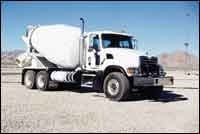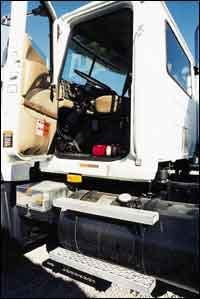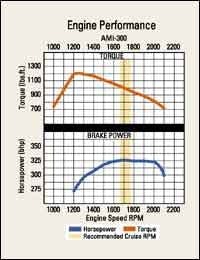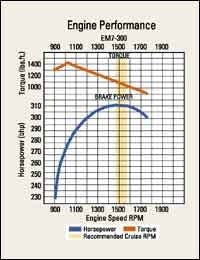Mack's Maxidynes Require Some Relearning
It was Déjà vu, the mental phenomenon that tells you you've been here before when you know you haven't. Except that I had. The place was the vast parking lot of the Las Vegas Motor Speedway, just before the World of Concrete show. I was in the seat of a new Mack Granite mixer, a lot like the one I drove and wrote about when it was introduced at the same place, during the same show, more than a year before.
But that truck's engine stopped revving about 1,800 rpm, and now I was winding this one to 2,100 rpm—just like all big diesels did when "Déjà vu" was a best-selling record album from Crosby, Stills, Nash & Young. That was in 1970, you may recall if you're as old as I, and you like their folksy music.
By then Mack's original Maxidyne had been out several years. That engine lugged down to 1,100 or 1,200 rpm, which meant a 5- or 6-speed transmission was adequate while 9-, 10- or 13-speed gearboxes were needed with engines that had much narrower operating ranges, which was most of 'em.
That 2,100-rpm Maxidyne went away about 1987, when Mack switched to a lower-speed version. Its rev range was 1,020 to 1,750 rpm, yet it pulled exactly as well as the higher-revving engine. I know because a colleague and I spent a day comparing two rigs that were identical except for their 300-hp engines and different axle ratios.
We cruised on level stretches, climbed long highway grades, and even drag raced on Mack's track in Allentown, Pa. The only performance difference was fuel economy: The then-new low-speed Maxidyne delivered about 0.2 mile per gallon better economy, if I recall correctly, which was the reason for the change. Lower rpm's save fuel.
So why would Mack go back to the higher, thirstier rev limit? To let the new Maxidyne's internal exhaust-gas recirculation system work, explained Steve Ginter, the vocational marketing manager at Mack's headquarters in Allentown. EGR cleanses diesel exhaust of enough nitrogen oxides to meet the latest EPA emissions limits, which went into effect last Oct. 1.
Mack uses internal EGR for engines in vocational trucks, and the more complex cooled EGR on highway models. Thus the name, Application Specific Engine Technology, or ASET, which includes the Maxidyne and the more conventional-torque Maxicruise and Econodyne engines.
I-EGR uses valve overlap to let a bit of exhaust bleed back into combustion chambers. Exhaust gas displaces oxygen, which lowers combustion temperatures, which in turn cuts NOx. Camshaft lobes are ground just-so to achieve the proper valve action, and it took a lot of theorizing and testing to get the grind right, engineers say.
I-EGR doesn't need special plumbing, extra valving or the jacketwater aftercooler used in the on-highway system. The downside is that I-EGR uses a bit more fuel. But that's not a major priority with operators of construction and trash trucks, who probably won't notice any penalty in everyday operations, Mack engineers say.
Veteran Maxidyne drivers will notice the new engine's weaker low-end "grunt," though. A small-fleet owner I met at a previous demonstration of the engines said his drivers noticed this, and griped about it. But less low-end torque means fewer broken U-joints and that'll save repair money, said another fleet owner at the same demo, last November in Allentown. He counted this as a real advantage.
The new AMI-300 engine makes its torque at higher rpm's, and makes less of it—1,200 pounds-feet at 1,200 rpm, compared to the older EM7-300's 1,425 pounds-feet at 1,020 rpm. You feel this while accelerating and upshifting, and while slowing and downshifting. Because horsepower with the new engine is also higher on the tachometer, you need to keep revs above 1,300 or 1,400.
Once revving, the AMI-300 produces more maximum horsepower—325 from about 1,650 rpm almost to 2,000, when it drops abruptly to 300 horsepower at 2,100, the advertised rating. The EM7-300 makes 310 horsepower at about 1,500 rpm, and drops off quickly before and after that point.
So if drivers keep revs up, they'll be happy with the new engine. They'll be even happier with one of the higher Maxidyne ratings, 335 hp/1,340 lb-ft. and 370 hp/1,480 lb-ft. Neither was available before.
The new Maxidynes' power and torque characteristics effectively shorten the operating range, so drivers need one extra transmission gear to get the job done, Ginter said. He and other professional Bulldoggers would prefer that you buy the recently introduced ES (for easy shift) T300 series triple-countershaft gearboxes, and these were in the two Granite mixer chassis I drove at the speedway near Las Vegas.
The Granite 10-wheel mixer shown here had the 300-hp Maxidyne mated to a 7-speed TM309M Maxitorque transmission. This has three low-low ratios for creeping and six on-pavement ratios (vs. a 5-speed used with the older engines). All ratios are in the same wide H-pattern, with the LL ratios gotten by flipping a thumb switch. If you shift fast, there are just enough steps to keep the engine between 1,400 (where serious horsepower begins) and 2,100 rpm.
Much better, I thought, was a 10-speed T310MLR in the other truck, a 12-wheel (with booster axle) chassis. Of course, this truck's engine also had 50 more horsepower, but extra ratios kept the engine well into its range and it felt lively all the time. This is a range-type transmission, like the better known Fuller LL models, which are also available in Granites.
Mack produces 17 different ES T300 models with five to 18 forward speeds and one to four reverse ratios. Some have extra-low ratios ideal for mixer work, and all have a number of mechanical improvements that make them shift as easily as the low-inertia, twin-countershaft Fullers. But the Maxitorques still have triple countershafts to share torque loads.
Older Maxitorques also shifted easily, "but not until they got broken in, which was at about 50,000 miles," Ginter related. "Our customers were telling us: 'We can't wait that long for the drivers to begin liking it' in a vocational operation, where you run only 30,000 miles a year. Now these shift easily right from the start."
However, several times the 10-speed popped out of 5th gear while coasting. Ginter later had technicians check this out, and they found that the rubber boot at the lever's base was stiff, pulling it toward neutral. The boot will be altered for future production, he said.
Some T300 models have a yellow up-down/forward-reverse switch on the shifter knob, instead of a reverse position in the shift pattern. This lets you change direction without moving the lever—most convenient while maneuvering in very tight quarters. It also provides multi-speed reverse ratios.
Although reverse is supposed to be limited to the four lowest ratios, I was able to keep upshifting the 10-speed into high range, getting as far as 7th and about 35 mph before I ran out of backing room. It was fun, but this is a serious advantage if the pour point is some distance from where you can turn around.
Let me sum up by recalling that "Teach Your Children Well" is one of the classic tunes on Déjà Vu, the record album, and any fleet operator might take that to heart when acquiring new equipment. A little training on new Maxidynes' nuances would do drivers some good.
If drivers know up front that higher revs are required, they'll take to the new engines well and you shouldn't have to listen to any complaints. And they will thank you if you order a transmission with a couple of extra gears.





